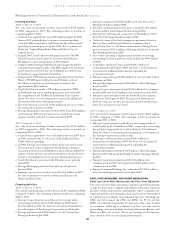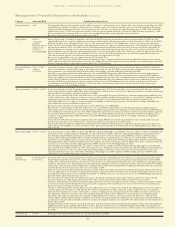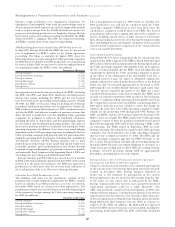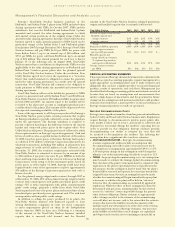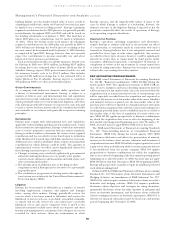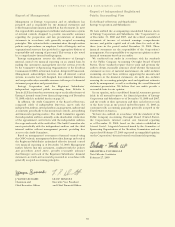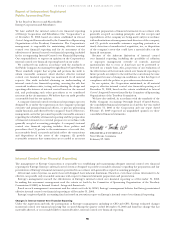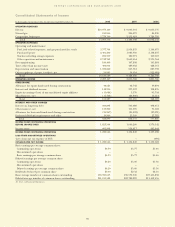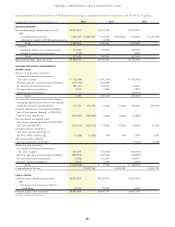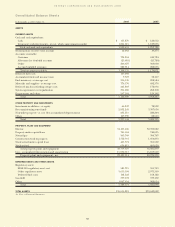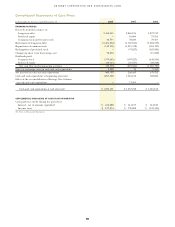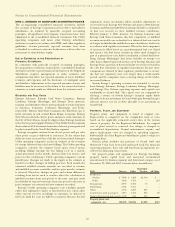Entergy 2008 Annual Report Download - page 55
Download and view the complete annual report
Please find page 55 of the 2008 Entergy annual report below. You can navigate through the pages in the report by either clicking on the pages listed below, or by using the keyword search tool below to find specific information within the annual report.53
ENTERGY CORPORATION AND SUBSIDIARIES 2008
5353
Management’s Financial Discussion and Analysis concluded
funding liability over the market-related value of assets, results in
a funding shortfall which, under the Pension Protection Act, must
be funded over a seven-year rolling period. Entergy’s minimum
required contributions for the 2009 plan year are generally payable
in installments throughout 2009 and 2010 and will be based on
the funding calculations as of January 1, 2009. The final date at
which 2009 plan year contributions may be made is September
15, 2010. Given the decline in the stock market, the minimum
required contributions for the 2009 plan year, payable in 2009 or
2010, will increase although the level of increase or timing of that
increase cannot be determined until the January 1, 2009 valuation
is completed by April 2009. Entergy, however, does not currently
expect the contributions to increase materially over and above
historical levels of pension contributions.
Total postretirement health care and life insurance benefit costs
for Entergy in 2008 were $93.4 million, including $24.7 million
in savings due to the estimated effect of future Medicare Part D
subsidies. Entergy expects 2009 postretirement health care and
life insurance benefit costs to be $105.2 million. This includes
a projected $24 million in savings due to the estimated effect of
future Medicare Part D subsidies. Entergy expects to contribute
$76 million in 2009 to its other postretirement plans.
OT H E R CONTINGE NCIES
As a company with multi-state domestic utility operations and
a history of international investments, Entergy is subject to a
number of federal, state, and international laws and regulations
and other factors and conditions in the areas in which it operates,
which potentially subject it to environmental, litigation, and other
risks. Entergy periodically evaluates its exposure for such risks and
records a reserve for those matters which are considered probable
and estimable in accordance with generally accepted accounting
principles.
Environmental
Entergy must comply with environmental laws and regulations
applicable to the handling and disposal of hazardous waste. Under
these various laws and regulations, Entergy could incur substantial
costs to restore properties consistent with the various standards.
Entergy conducts studies to determine the extent of any required
remediation and has recorded reserves based upon its evaluation
of the likelihood of loss and expected dollar amount for each issue.
Additional sites could be identified which require environmental
remediation for which Entergy could be liable. The amounts of
environmental reserves recorded can be significantly affected by
the following external events or conditions:
nChanges to existing state or federal regulation by governmental
authorities having jurisdiction over air quality, water quality,
control of toxic substances and hazardous and solid wastes, and
other environmental matters.
nThe identification of additional sites or the filing of other
complaints in which Entergy may be asserted to be a potentially
responsible party.
nThe resolution or progression of existing matters through the
court system or resolution by the United States Environmental
Protection Agency (EPA).
Litigation
Entergy has been named as defendant in a number of lawsuits
involving employment, ratepayer, and injuries and damages
issues, among other matters. Entergy periodically reviews the
cases in which it has been named as defendant and assesses the
likelihood of loss in each case as probable, reasonably estimable,
or remote and records reserves for cases which have a probable
likelihood of loss and can be estimated. Notes 2 and 8 to the
financial statements include more detail on ratepayer and other
lawsuits and management’s assessment of the adequacy of reserves
recorded for these matters. Given the environment in which
Entergy operates, and the unpredictable nature of many of the
cases in which Entergy is named as a defendant, however, the
ultimate outcome of the litigation Entergy is exposed to has the
potential to materially affect the results of operations of Entergy,
or its operating company subsidiaries.
Uncertain Tax Positions
Entergy’s operations, including acquisitions and divestitures,
require Entergy to evaluate risks such as the potential tax effects
of a transaction, or warranties made in connection with such a
transaction. Entergy believes that it has adequately assessed and
provided for these types of risks, where applicable. Any reserves
recorded for these types of issues, however, could be significantly
affected by events such as claims made by third parties under
warranties, additional transactions contemplated by Entergy, or
completion of reviews of the tax treatment of certain transactions
or issues by taxing authorities. Entergy does not expect a material
adverse effect on earnings from these matters.
NEW ACCOUNTING PRONOUNCEMENTS
The FASB issued Statement of Financial Accounting Standards
No. 141(R), “Business Combinations” (SFAS 141(R)) during the
fourth quarter 2007. The significant provisions of SFAS 141R are
that: (i) assets, liabilities and non-controlling (minority) interests
will be measured at fair market value; (ii) costs associated with the
acquisition such as transaction-related costs or restructuring costs
will be separately recorded from the acquisition and expensed as
incurred; (iii) any excess of fair market value of the assets, liabilities
and minority interests acquired over the fair market value of the
purchase price will be recognized as a bargain purchase and a gain
recorded at the acquisition date; and (iv) contractual contingencies
resulting in potential future assets or liabilities may be recorded at
fair market value at the date of acquisition if certain criteria are
met. SFAS 141(R) applies prospectively to business combinations
for which the acquisition date is on or after the beginning of the
first annual reporting period beginning on or after December 15,
2008. An entity may not apply SFAS 141(R) before that date.
The FASB issued Statement of Financial Accounting Standards
No. 160, “Noncontrolling Interests in Consolidated Financial
Statements” (SFAS 160) during the fourth quarter 2007. SFAS
160 enhances disclosures and affects the presentation of minority
interests in the balance sheet, income statement and statement of
comprehensive income. SFAS 160 will also require a parent to record
a gain or loss when a subsidiary in which it retains a minority interest
is deconsolidated from the parent company. SFAS 160 applies
prospectively to business combinations for which the acquisition
date is on or after the beginning of the first annual reporting period
beginning on or after December 15, 2008. An entity may not apply
SFAS 160 before that date. Pursuant to SFAS 160, beginning in 2009,
Entergy will prospectively reclassify as equity its subsidiary preferred
stock without sinking fund.
In March 2008 the FASB issued Statement of Financial Accounting
Standards No. 161 “Disclosures about Derivative Instruments and
Hedging Activities, an amendment of FASB Statement No. 133”
(SFAS 161), which requires enhanced disclosures about an entity’s
derivative and hedging activities. SFAS 161 requires qualitative
disclosures about objectives and strategies for using derivatives,
quantitative disclosures about fair value amounts of and gains and
losses on derivative instruments, and disclosures about credit-risk-
related contingent features in derivative agreements. SFAS 161 is
effective for financial statements issued for fiscal years and interim
periods beginning after November 15, 2008.


